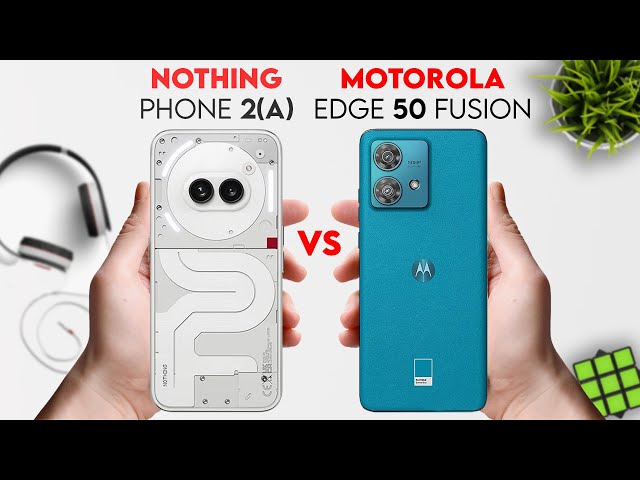The mid-range smartphone market is a battleground of innovation, with manufacturers vying for consumer attention with feature-packed devices at attractive price points. Two recent contenders have captured the spotlight: the Motorola Edge 50 Fusion and the Nothing Phone (2a). Both offer compelling features and target value-conscious users, but which one reigns supreme? This in-depth comparison equips you with the knowledge to make an informed decision and select the phone that best aligns with your needs.

Design and Display: A Tale of Two Screens
The Motorola Edge 50 Fusion and Nothing Phone (2a) boast contemporary designs with punch-hole displays, minimizing bezels for a premium aesthetic. However, their approaches diverge here. The Edge 50 Fusion takes the path of elegance, featuring a captivating 3D curved display that seamlessly blends into the slim frame. While it offers a slightly thicker top and bottom bezel compared to the Nothing Phone (2a), the curvature adds a touch of sophistication and a more immersive viewing experience.
The Nothing Phone (2a) counters with a unique flat-panel display that incorporates its signature Glyph Interface. This ingenious design element features 26 individually addressable LED light zones that illuminate notifications, calls, and while charging, adding a playful and interactive element to the phone’s aesthetics.
Both phones share the same FHD+ 10-bit panel, ensuring exceptional image quality with vibrant colors and sharp details. However, the Motorola Edge 50 Fusion boasts a higher refresh rate of 144Hz than the Nothing Phone (a)’s 120Hz. This translates to smoother visuals, especially noticeable in fast-paced games or scrolling through content. Additionally, the Edge 50 Fusion boasts a peak brightness of 1600 nits, surpassing the Nothing Phone (2a)’s 1300 nits. This advantage is particularly beneficial for outdoor use under bright sunlight.
Durability is another factor to consider. The Motorola Edge 50 Fusion boasts an IP68 water and dust resistance rating, signifying it can withstand submersion in up to 1.5 meters of water for 30 minutes and is protected against dust ingress. The Nothing Phone (2a) offers a lower IP54 rating, indicating some protection against dust and water splashes but not complete submersion.
When it comes to weight and size, the Motorola Edge 50 Fusion takes the lead again. Its sleek design measures just 7.9mm thin and weighs a mere 175 grams, making it a comfortable phone to hold and carry. The Nothing Phone (2a) is slightly thicker and heavier but remains within a manageable range.
For color options, the Motorola Edge 50 Fusion caters to diverse preferences. It comes in three distinct choices: Hot Pink and Marshmallow Blue, both featuring a stylish vegan leather finish and Forest Blue with a polymethyl methacrylate (PMMA) back panel. The Nothing Phone (2a) keeps things simple with Black and White options, both sporting a plastic frame and back panel.
The Verdict on Design and Display:
The choice between these two phones in terms of design and display depends on your priorities. If you prioritize a luxurious aesthetic, and immersive viewing with a curved display and superior brightness, the Motorola Edge 50 Fusion might be the better choice. However, if you seek a unique and interactive design with the Glyph Interface and prioritize a flat display, the Nothing Phone (2a) could be more appealing.
Performance, Battery, and Software: Powering Your Everyday
Under the hood, the Motorola Edge 50 Fusion and Nothing Phone (2a) take slightly different approaches. The Motorola Edge 50 Fusion is powered by the Qualcomm Snapdragon 7s Gen 2 chip, a proven performer in the mid-range segment. The Nothing Phone (2a), on the other hand, boasts the custom MediaTek Dimensity 7200 Pro SoC. Both processors deliver capable performance for everyday tasks like browsing the web, social media, and streaming content. However, the Nothing Phone (2a) claims to offer optimal power consumption thanks to its custom chipset.
Both phones pack a generous 5,000mAh battery, ensuring you can stay powered throughout the day without worrying about running out of juice. However, the Motorola Edge 50 Fusion boasts a clear advantage in the charging department. It supports 68W TurboPower fast charging, allowing you to quickly replenish the battery when needed. The Nothing Phone (2a) utilizes a slower charging solution, the specific wattage is yet to be revealed by the manufacturer.
FAQs
Q: Which phone has a better camera, the Motorola Edge 50 Fusion or the Nothing Phone (2a)?
A: It depends on your needs. The Nothing Phone (2a) offers an additional 50MP ultra-wide sensor for capturing wider scenes, while the Motorola Edge 50 Fusion focuses on a single high-resolution 50MP main sensor with OIS.
Q: Which phone has a faster refresh rate display?
A: The Motorola Edge 50 Fusion boasts a 144Hz refresh rate display compared to the Nothing Phone (2a)’s 120Hz display.
Q: Which phone has a longer battery life?
A: Both phones pack a 5,000mAh battery, so battery life is expected to be similar. However, the Motorola Edge 50 Fusion boasts faster charging capabilities.
Q: Which phone has a more unique design?
A: The Nothing Phone (2a) stands out with its transparent back panel and the Glyph Interface with its customizable LED lights.




